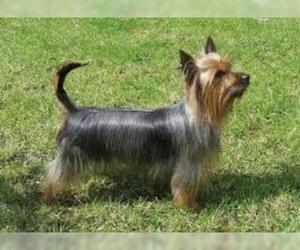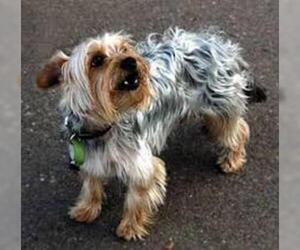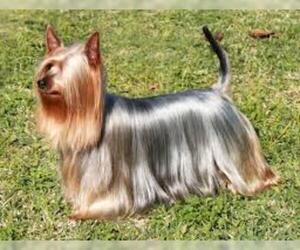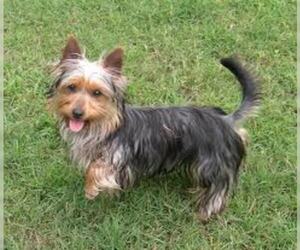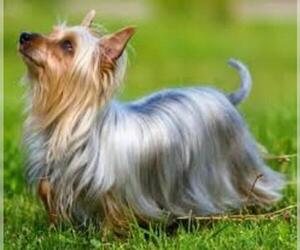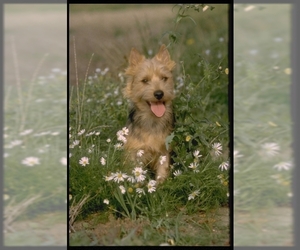
All about Silky Terrier dog breed
A.K.A. :Sydney Silky, Silky, silky dog, Silky Aussie, Aussie Silky
Size
Grooming requirements
Exercise requirements
Good with other dogs
Watchdog ability
Energetic
Training requirements
Playful
Affectionate
Good with other pets
Good with children
Good with strangers
Winter
Summer
Healthiness
Protective
Life Span
| Pure Breeds | Member |
| Breeds A - Z | S |
| Breeds by Group | Terrier Toy |
| Breeds by Trait | Hypoallergenic Low Shedding |
| Overview: | The Silky Terrier is a charming and spirited companion, originating in Australia in the late 19th century. Bred from the Yorkshire and Australian Terriers, they were developed to be versatile pets, suitable for both companionship and pest control. Physically, Silkys are small, elegant dogs, typically weighing between 8-10 pounds, distinguished by their long, flowing, steel-blue and tan coat that is remarkably soft to the touch – hence their name. Beneath this beautiful coat lies a sturdy and agile body. Temperamentally, they are known for being alert, confident, and intelligent, possessing a typical terrier zest for life. Despite their small size, they are quite active and enjoy playtime, but also relish curling up for a cuddle. Their adaptable nature makes them suitable for various living situations, including apartment living, provided they receive regular exercise and mental stimulation. They can be good with respectful children and other pets, though early socialization is key. While generally healthy, potential owners should be aware of breed-specific concerns such as patellar luxation and dental issues. With proper care and training, a Silky Terrier makes a delightful and devoted family member. |
F.A.Q.
All You Need to Know About the Silky Terrier BreedThe Silky Terrier, originating from Australia, is a delightful and spirited toy breed perfect for various homes. Known for their silky, flowing blue and tan coat that resembles human hair, these dogs are both elegant and robust. Temperament-wise, they are confident, intelligent, and affectionate, making them excellent companions. Their alert nature means they can be good watchdogs, though not overly yappy. They adapt well to apartment living due to their small size, provided they receive adequate daily exercise through walks and indoor play. While generally good with respectful children and other pets, early socialization is key. Grooming requirements include regular brushing to prevent matting and occasional professional trimming to maintain their coat. Exercise needs are moderate, with daily walks sufficient to keep them happy and healthy. Common health considerations are generally minimal, but like many small breeds, they can be prone to patellar luxation and dental issues. A Silky Terrier puppy or adult makes a loyal, loving, and entertaining addition to the right family.
The average weight for a Silky Terrier is generally between 8 to 10 pounds. Adult male and female Silky Terriers typically fall within this healthy weight range, with little significant variation between sexes. This makes them a small but sturdy companion breed.
Silky Terrier Height: How Tall is a Silky Terrier?
Curious about the typical Silky Terrier height? These charming companions are known for their compact size, making them excellent choices for various living situations. When fully grown, an adult Silky Terrier generally stands between 9 to 10 inches tall at the shoulder.This average size can have slight variations, with some individuals falling just outside this range. While there isn't a significant difference in height between male and female Silky Terriers, individual genetics can play a role in whether a specific dog is at the lower or upper end of the spectrum. Rest assured, regardless of a tiny inch here or there, your Silky will always be a perfectly pint-sized pal!The Silky Terrier colors officially recognized by major kennel clubs like the AKC are a combination of blue and tan. This typically means a steel blue or dark blue on the body and head, with rich tan markings on the muzzle, cheeks, legs, and under the tail. The blue should be deep and clear, and the tan should be a vibrant, rich shade.Rare coat types and exotic Silky Terrier variations like solid blue, solid tan, or entirely different colors such as cream, white, brindle, fawn, merle, chocolate, or lilac are not accepted by the AKC or other major breed clubs for showing or breeding within the breed standard. While these rare Silky Terrier colors might appear due to genetic variations, they are considered disqualifications in the show ring and are not typical of the breed. Potential adopters or buyers should be aware that such non-standard colors, while unique, do not align with the breed's established appearance and may sometimes be associated with irresponsible breeding practices. Focus on the classic blue and tan for an AKC recognized Silky Terrier colors experience.
The Silky Terrier personality is a delightful blend of vivaciousness and affection. These small dogs are known for their lively and spirited nature, always ready for an adventure or a cuddle. They are exceptionally friendly and loyal companions, forming strong bonds with their families. While they possess the typical terrier spunk, they are generally sociable and enjoy being part of family activities.The temperament of Silky Terrier is also highly adaptable, making them suitable for various living situations, including apartment living, provided they receive sufficient exercise and mental stimulation. They thrive on human companionship and can be prone to separation anxiety if left alone for extended periods.Regarding children, Silkys can be good family pets, especially with older, respectful children who understand how to interact with a small dog. However, like all breeds, early socialization is key. With other pets, they can coexist peacefully, particularly if introduced at a young age. However, their terrier instincts might lead them to chase smaller critters, so introductions should be supervised. Overall, the Silky Terrier is a charming, intelligent, and affectionate breed perfect for those seeking an engaging and devoted companion.
Silky Terrier Temperament: A Silky Terrier is a spirited, affectionate, and playful companion dog. They are known for their loyal and sociable nature, thriving on human interaction and forming strong bonds with their families. These charming little dogs are generally friendly with people and, with proper socialization, can adapt well to various home environments, including apartment living, provided they receive sufficient exercise and mental stimulation.While generally good with respectful children, supervision is always recommended, as with any breed. Their small size can make them vulnerable to rough play. Regarding other pets, Silkys can coexist peacefully with other dogs and cats if introduced properly, though their strong prey drive might make them inclined to chase smaller, fast-moving animals.Silkys are intelligent and eager to please, but can sometimes exhibit a stubborn streak and a sensitive nature. Consistent, positive reinforcement training methods work best. They are generally not overly sensitive to household noise but prefer a calm and loving environment. Their bold and confident personality in a small package makes them excellent watchdogs, often alerting their owners to anything unusual with a characteristic bark.
Silky Terrier Care: Daily Maintenance & Health TipsSilky Terrier care involves consistent attention to grooming, moderate exercise, and a balanced diet. Despite their name, Silky Terriers are not brachycephalic; however, like many small breeds, they do require specific care.Grooming Needs: Daily brushing of their long, silky coat is essential to prevent mats and tangles. Professional grooming every 4-6 weeks for trimming and tidying is also recommended. Bathe as needed, typically every 2-4 weeks, using a mild dog shampoo to keep their coat healthy and clean. Pay close attention to ear cleaning weekly to prevent infections. Dental care is crucial; brush teeth daily or several times a week to prevent periodontal disease, a common issue in small breeds. Their nails should be trimmed every 2-3 weeks.Exercise Limitations: Silky Terriers are a low-energy dog breed, needing moderate exercise. Daily short walks (20-30 minutes) and indoor playtime are usually sufficient to keep them happy and healthy. Avoid over-exercising, especially in extreme temperatures, as their smaller size makes them more sensitive.Dietary Considerations: Feed a high-quality small-breed dog food appropriate for their life stage. Portion control is vital to prevent obesity, as Silky Terriers can gain weight easily. Consult your vet for specific dietary recommendations.Common Health Concerns: Be vigilant for skin issues, which can sometimes arise from allergies or poor grooming. Regular dental care is paramount to prevent dental disease. Weight management is key to preventing other health complications. Regular vet check-ups are essential for early detection and prevention of potential health problems.How to Care for a Silky Terrier: Consistent daily maintenance, including grooming, exercise, and proper nutrition, is key to a healthy and happy Silky Terrier. Early socialization and training are also important for their well-being.
The Silky Terrier activity level is moderate, balancing lively bursts of energy with a love for cozy relaxation. They are generally adaptable, suitable for both moderately active and lower-energy households that can still provide consistent stimulation.How active are Silky Terrier? These charming little dogs are known for their playful and inquisitive nature. They are not high-strung but require daily engagement. Their Silky Terrier exercise needs include a daily walk of 20-30 minutes, which can be broken into shorter strolls. Beyond walks, they thrive on interactive playtime, such as fetch in a secure yard or engaging in puzzle toys indoors. They enjoy opportunities to explore and use their keen senses.While they enjoy being active, Silky Terriers are not built for endurance. They balance short bursts of energy with long periods of rest, often found curled up on a soft bed or on a lap after playtime.Due to their brachycephalic (short-nosed) anatomy, Silky Terriers have certain limitations. It’s crucial to avoid strenuous exercise in hot or humid weather to prevent overheating and breathing difficulties. Always ensure they have access to fresh water and shade. They are not ideal for long-distance running or intense agility training, but they can excel in obedience and tricks that challenge their minds.Overall, a Silky Terrier will happily join you for a brisk walk, engage in playful games, and then settle down for a good nap. They are not typically suited for highly active families seeking a jogging or hiking companion for long distances, but they are perfect for those looking for an affectionate, playful, and intelligent companion who enjoys daily activity and plenty of cuddle time.
Silky Terriers are not brachycephalic, so brachycephalic dog care practices are typically unnecessary. However, their small frame and fine coat make them vulnerable to heat sensitivity, especially in hot climates or during vigorous activity. Providing hydration, shade, and rest breaks is essential. Spinal problems such as intervertebral disc disease (IVDD) may occur with age or poor conditioning, particularly in dogs that jump frequently or lack core strength.
Breed Breakdown: What Experts Say About the Silky Terrier
I'd rate the "Size" trait of the Silky Terrier breed a 2 on a scale from 1 to 10.Silky Terriers are undeniably small dogs, typically standing around 9-10 inches tall and weighing between 8-11 pounds. Their build is dainty and compact, truly embodying the "toy" or "miniature" designation. When compared to the vast spectrum of dog breeds, even within companion dog categories, they consistently fall into the smaller end of the scale. A "1" would be reserved for breeds like the Chihuahua, which can be even more minuscule, but the Silky is just a hair larger and a bit more robust in structure.This small stature makes the Silky Terrier exceptionally well-suited for apartment living and is a fantastic choice for travel. Their compact size means they can easily navigate smaller spaces, are comfortable in carriers, and are generally welcome in more places than larger breeds. They are an ideal companion for households with space constraints, as they don't require extensive living areas to thrive, though they do need regular exercise.
I would rate the grooming requirements of a Silky Terrier as a 7/10. While they aren't the absolute highest maintenance, their long, fine, single coat is a significant factor. It's prone to matting and tangling, requiring daily brushing to prevent discomfort and extensive professional grooming. Silky Terriers are low-shedding, which is a plus for allergy sufferers, but this also means their hair keeps growing and needs regular trimming to maintain health and hygiene, particularly around the eyes, ears, and paws. Their drop ears also require regular cleaning to prevent infections, and like all dogs, routine nail trims are essential. While not particularly prone to skin fold issues, their delicate skin can be susceptible to dryness or irritation if not properly cared for. Compared to many short-coated or even some double-coated breeds, a Silky Terrier definitely requires more frequent and specialized grooming to keep their coat healthy and prevent mats, making them a higher-maintenance option for grooming among companion dogs.
I would rate the Silky Terrier's "Exercise Requirements" at a 6.While they are small, Silkys are not "lap dogs" in the traditional sense and possess a surprising amount of energy and an inquisitive nature. They are lively and playful, enjoying regular activity to stay mentally and physically stimulated. Their energy levels are higher than many other toy breeds, and they genuinely enjoy walks and playtime. They tolerate sustained movement well for their size and are quite agile, often excelling in canine sports like agility at a foundational level.However, they are not a breed that requires extensive, endurance-based exercise. A good 30-45 minute walk daily, perhaps split into two shorter outings, combined with dedicated playtime (fetch, tug, or puzzle toys) in a securely fenced yard or indoors, is typically sufficient. They are not brachycephalic, so they don't have the severe respiratory limitations that some other small breeds face, allowing them to enjoy more vigorous play. While they will certainly enjoy more activity if offered, they do not require hours of strenuous exercise to be well-behaved and healthy. They thrive with structured routines that include consistent opportunities to move and explore, preventing boredom and potential destructive behaviors, but they are also content to cuddle up on the couch after their exercise needs are met.
I would rate the Silky Terrier's "Watchdog Ability" at a 7.Silky Terriers are surprisingly alert and make excellent little watchdogs. They possess a keen awareness of their surroundings and are quick to notice anything out of the ordinary, whether it's an unfamiliar sound, a car pulling up, or someone approaching the door. This translates into frequent and often insistent barking behavior, which, while sometimes excessive for some owners, is precisely what makes them effective. Their territorial instincts are present, and they will certainly sound the alarm, letting everyone in the house know if something is amiss. While they are small and not physically capable of deterring a determined intruder, their persistent barking and bold demeanor can certainly provide meaningful early warnings. They are not passive companions in this regard; they are actively engaged in monitoring their home environment and will vocally communicate any perceived threats.
Rating the "Good with Other Dogs" trait of the Silky Terrier breed on a scale from 1 to 10, I would give them a 6.Silky Terriers generally fall in the middle when it comes to their compatibility with other dogs. While they are not typically aggressive or overly dominant, their strong terrier prey drive and independent nature can sometimes manifest as a bossy or feisty attitude, especially towards dogs they perceive as challengers or those that infringe on their personal space. They are not naturally as indiscriminately dog-friendly as some other breeds, and their small size can sometimes lead to them being either overly confident and nippy, or conversely, easily intimidated by larger, more boisterous dogs.With proper, early socialization, Silkys can learn to coexist peacefully and even enjoy the company of other canines. They thrive when raised with other dogs, understanding canine communication from a young age. However, introductions to unfamiliar dogs, especially those of vastly different sizes or energy levels, often require careful supervision and a structured approach. They may not instantly welcome every new dog into their circle, and a lack of consistent training and socialization can lead to them becoming territorial or prone to squabbles over resources. In a multi-dog household, they can be good companions, but their strong personalities mean they generally prefer to be the center of attention and may not always appreciate a new canine taking their spotlight without proper integration. They can certainly be dog-friendly, but it's more often a result of good training and thoughtful management rather than an innate, universal amiability.
I would rate the Silky Terrier's "Energetic" trait as a 7 out of 10.Silky Terriers are certainly not low-energy dogs; they are true terriers at heart, brimming with a lively and curious spirit. They possess a good amount of endurance for their size and love to engage in playful activities, requiring regular physical and mental stimulation to prevent boredom. You'll find them eager participants in walks, games of fetch, and even some agility or obedience work. Compared to many companion breeds, they are naturally active and spirited rather than laid-back lapdogs.However, their brachycephalic (short-nosed) anatomy, while not as pronounced as in some other breeds like Bulldogs or Pugs, can still have an impact on their stamina and exercise tolerance, especially in hot or humid weather. While they can and enjoy participating in outdoor and athletic activities, they are not built for long, strenuous runs or extreme endurance challenges that a longer-snouted, larger terrier might easily handle. Their smaller size also limits the scale of their activity; a "long" walk for a Silky Terrier is different from a "long" walk for a Border Collie. Therefore, while energetic and certainly requiring a good outlet for their zest, they aren't quite at the extremely high end of the energy spectrum that some working or herding breeds occupy.
I'd rate the Silky Terrier's "Training Requirements" a 6 out of 10.While intelligent and capable of learning, Silkies aren't always the easiest to train. They possess a delightful but sometimes challenging combination of terrier spunk and an independent streak. Their intelligence means they can grasp commands quickly, but their stubbornness can lead to selective hearing if something more exciting is happening. Their attention span can be good in focused sessions but may wane if training isn't kept engaging and fun. They respond very well to positive reinforcement, especially food-based rewards and praise, but harsh methods are counterproductive and will likely result in a shut-down or defiant dog. Consistency is absolutely crucial; any slack in rules will be quickly exploited. This breed is not entirely beginner-friendly in the sense that a novice owner might find their independent nature frustrating, and they thrive with an owner who can provide clear, consistent, and engaging training with a good sense of humor and patience. They benefit from structured routines but are also adaptable once they understand the boundaries.
I would rate the Silky Terrier's "Playful" trait a solid 9 out of 10. They are, without a doubt, a naturally spirited breed. Silky Terriers possess an incredibly energetic and fun-loving nature that consistently shines through in their daily lives. They have a high typical activity level and absolutely adore games and interaction, often initiating play with their owners. Their attention-seeking behavior is frequently expressed through playful antics, and their response to toys and playtime is enthusiastic and engaging. They love to chase, fetch, and engage in boisterous games, showing an overall zest for life that is infectious. Compared to many other companion dogs, they are definitely more on the "go-go-go" side, always ready for an adventure or a good romp, making them extremely entertaining companions.
I would rate the "Affectionate" trait of the Silky Terrier a 9 out of 10.Silky Terriers are renowned for their intensely loving and people-oriented nature. They possess an almost insatiable desire for human companionship, often displaying an unwavering loyalty to their families. Physical closeness is a hallmark of the breed; they are enthusiastic cuddlers and dedicated lap-sitters, thriving on the warmth and security of being near their owners. Their sensitivity to owner emotions is also quite high, often seeming to pick up on their family's mood. Furthermore, the "Velcro dog" description perfectly fits the Silky Terrier, as they tend to follow their family members from room to room, preferring not to be left out of any activity. This breed truly thrives on affection and connection, making them less independent and far more dependent on their humans for emotional fulfillment compared to many other companion breeds.
I would rate the "Good with Other Pets" trait of the Silky Terrier a 6 out of 10.Silky Terriers are generally good with other dogs, especially those of similar size and energy levels, and can be quite playful. They are intelligent and trainable, and with early and consistent socialization, they can learn to coexist peacefully with other canine companions. However, their terrier heritage means they possess a notable prey drive, which can make living with cats and other small, furry pets challenging. While some Silkys can be raised to accept a cat they grew up with, their instinct to chase and "hunt" smaller animals is strong. Resource guarding, while not typically a dominant trait, can emerge if not addressed through training and management in a multi-pet household, particularly around food or favored toys. They thrive in environments where they are the center of attention, and while adaptable, they may require extra supervision and management to ensure all pets feel secure and respected, especially when integrating new animals. Their natural sociability leans more towards humans and dogs, but successful interspecies relationships often require significant effort in terms of training, supervision, and careful introductions rather than being a purely natural inclination.
The Silky Terrier rates a solid 6 out of 10 for "Good with Children."While inherently affectionate and playful, especially with their own families, Silkies are true terriers at heart. This means they possess a confident, sometimes feisty, personality that might not always be the best match for very young or boisterous children. They generally have a good tolerance for noise and handling from respectful children, but they can be easily overwhelmed or become nippy if teased, roughly handled, or if their personal space is repeatedly invaded without supervision. They are not naturally as patient or forgiving as some larger, more placid breeds. With older, more considerate children who understand how to interact with a small dog and with proper socialization and training from a young age, a Silky Terrier can thrive as a loving and playful companion. However, their size and spirited nature necessitate supervision and teaching both the dog and the children how to interact safely.
I'd rate the Silky Terrier's "Good with Strangers" trait a 6 out of 10. While not typically aggressive, Silkys are often more reserved and can be a bit wary of unfamiliar adults compared to some other very outgoing breeds. They tend to be more discerning, evaluating new people before fully accepting them. They might bark initially at a stranger, not out of aggression, but to alert their owners or express their wariness. With proper socialization from a young age, they can become quite amiable and polite with guests, and they generally adapt well to public environments as long as their human is present. However, they aren't usually the type to exuberantly greet every new person they meet; their friendliness often needs to be earned or at least facilitated by their owner's positive cues. They're more likely to be content observing from a comfortable distance before engaging.
I would rate the Silky Terrier's "Winter" tolerance at a 2. They are highly sensitive to cold. Their single-layer, fine, silky coat, while long, offers very little insulation against cold temperatures. Being a small breed, they have a larger surface area to volume ratio, making them lose heat more quickly than larger dogs. They lack the body fat reserves that would provide an extra layer of warmth, and their small size makes them particularly susceptible to rapid drops in body temperature, increasing the risk of hypothermia even in moderately cold weather. While not brachycephalic, their delicate nature and lack of natural cold protection mean they cannot safely enjoy extended outdoor activity in cold climates. Compared to many other companion dogs, Silky Terriers absolutely require special care during winter months, including warm clothing like sweaters or coats for even short outdoor excursions, and ideally, their outdoor time should be very limited in freezing or near-freezing conditions. They are primarily indoor dogs and thrive in warm environments.
Rating: 4The Silky Terrier, while not as severely affected as some brachycephalic breeds, does exhibit a moderate sensitivity to heat, warranting a rating of 4. Their relatively short muzzle, though not extreme, still presents a slight disadvantage in efficient panting compared to long-nosed breeds, impacting their ability to regulate body temperature effectively. They are certainly at a higher risk of heatstroke than many companion dogs if not properly managed during hot weather. Their recommended outdoor activity levels should be significantly curtailed during peak heat hours, and vigorous exercise is best reserved for cooler parts of the day or indoors in air conditioning. Special care is definitely required for Silky Terriers in the summer months compared to many other companion dogs. They will need consistent access to shade and fresh water, and air conditioning is often essential for their comfort and safety when temperatures climb. Their small size can also make them more susceptible to overheating as their surface area to volume ratio allows for quicker heat absorption.
I would rate the Silky Terrier's "Healthiness" trait as a 7 out of 10.Silky Terriers are generally considered a robust and healthy breed, particularly when sourced from responsible breeders who prioritize health testing. They have a good average life expectancy, typically ranging from 12 to 15 years, which is on the higher end for small breeds. They don't have the severe breathing difficulties seen in brachycephalic breeds, nor the widespread debilitating joint issues that plague some larger dogs.However, they are not without their breed-specific predispositions. Patellar luxation (slipping kneecaps) is a concern in the breed, as is Legg-Calve-Perthes disease (a hip joint disorder). While not as common, some individuals can be prone to epilepsy, diabetes, and certain eye conditions like cataracts or progressive retinal atrophy. Dental health can also be a more significant concern due to their small mouths, requiring consistent preventative care. Therefore, while generally healthy, they aren't entirely free from genetic vulnerabilities, and prospective owners should be prepared for potential monitoring and preventative care, especially regarding joint and dental health. They are not considered excessively high-maintenance in terms of health compared to some breeds, but responsible ownership certainly plays a significant role in their overall well-being.
I would rate the "Protective" trait of the Silky Terrier breed at a 6 out of 10.While Silky Terriers are certainly alert and possess strong territorial instincts for their size, making them excellent watchdogs, their protective capabilities are primarily limited to alerting their owners. They are incredibly loyal to their families and will bark at strangers or unusual sounds, demonstrating a readiness to defend their perceived territory. However, due to their small stature, they are not physically capable of offering meaningful protection as a guard dog. Their reaction to strangers, while often initially wary and vocal, rarely escalates beyond that. They are first and foremost companion dogs, designed to be loving and engaged members of the family, and while they will diligently "sound the alarm," they are not equipped to physically deter a threat.
I would rate the "Life Span" trait of the Silky Terrier a 7 out of 10.Silky Terriers are generally considered a long-lived breed compared to many other companion dogs. Their average life expectancy typically ranges from 12 to 15 years, with many individuals living well into their late teens. While they are susceptible to some breed-specific health issues like patellar luxation, Legg-Calve-Perthes disease, and certain eye conditions, these are often manageable with early diagnosis and proper veterinary care. Responsible breeding practices play a significant role in minimizing the prevalence of these genetic predispositions, and good daily care, including a balanced diet, regular exercise, and preventative veterinary check-ups, further contributes to their longevity. They are not considered short-lived, and their robust nature often allows them to enjoy a good quality of life for an extended period.
Silky Terrier Dogs for adoptionSee all dogs for adoption
Silky Terrier BreedersSee all breeders
Similar Dog Breeds for Silky Terrier
Breed Mixes of Silky Terrier
Quick Breed Selector 0 - not important, 1 - smallest, 10 - largest
Variants & Mistakes :Silky Terrior, Silk Terrier, Silky T, Silky Te, Silky Terier, Silky Terriar, Silky Terry, Silky Terrir, Silky Terri, Silky Terr, Silky Tarrer, Silky Tearer, Silky Tirer, Silky Torier, Silky Turrier, Silky Terryer, Silky Tereir, Silky Terrrier, Silky Tirrer, Silky Torrer, Silky Turrer, Silk Terier, Silkie Terrier, Siky Terrier, Sily Terrier, Sillky Terrier, Silley Terrier, Silkye Terrier, Silku Terrier, Silcy Terrier, Silky Tere, Silky Teree, Silky Terra, Silky Terre, Silky Terreir, Silky Terrie, Silky Terrey, Silky Terreyer, Silky Terreyor, Silky Terryor, Silky Terirer

